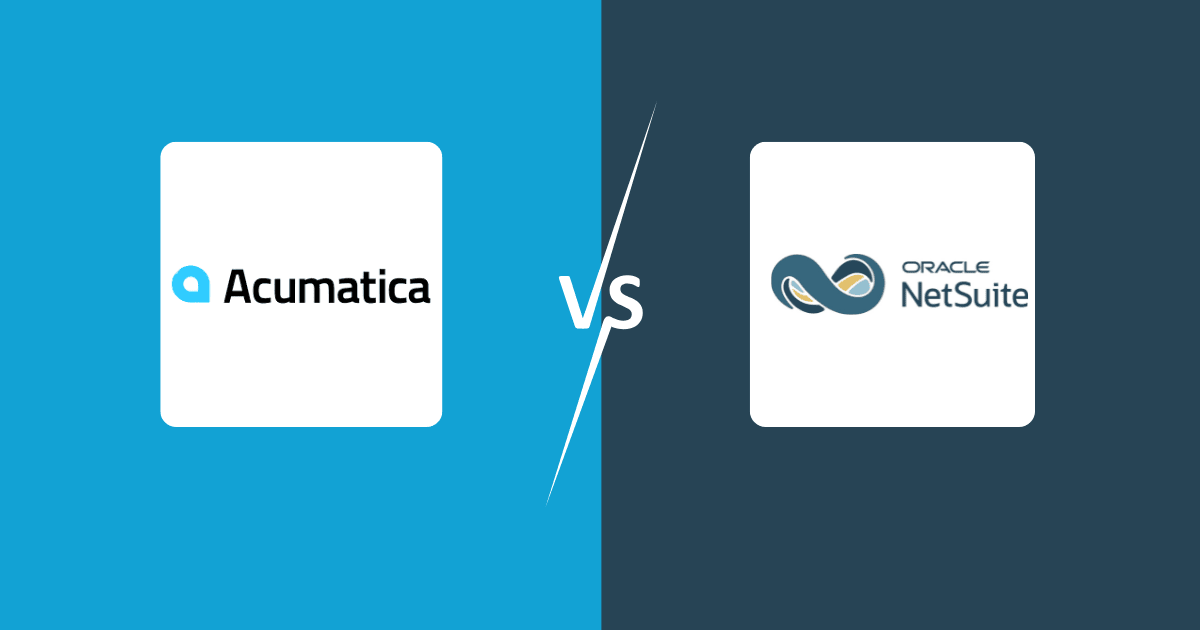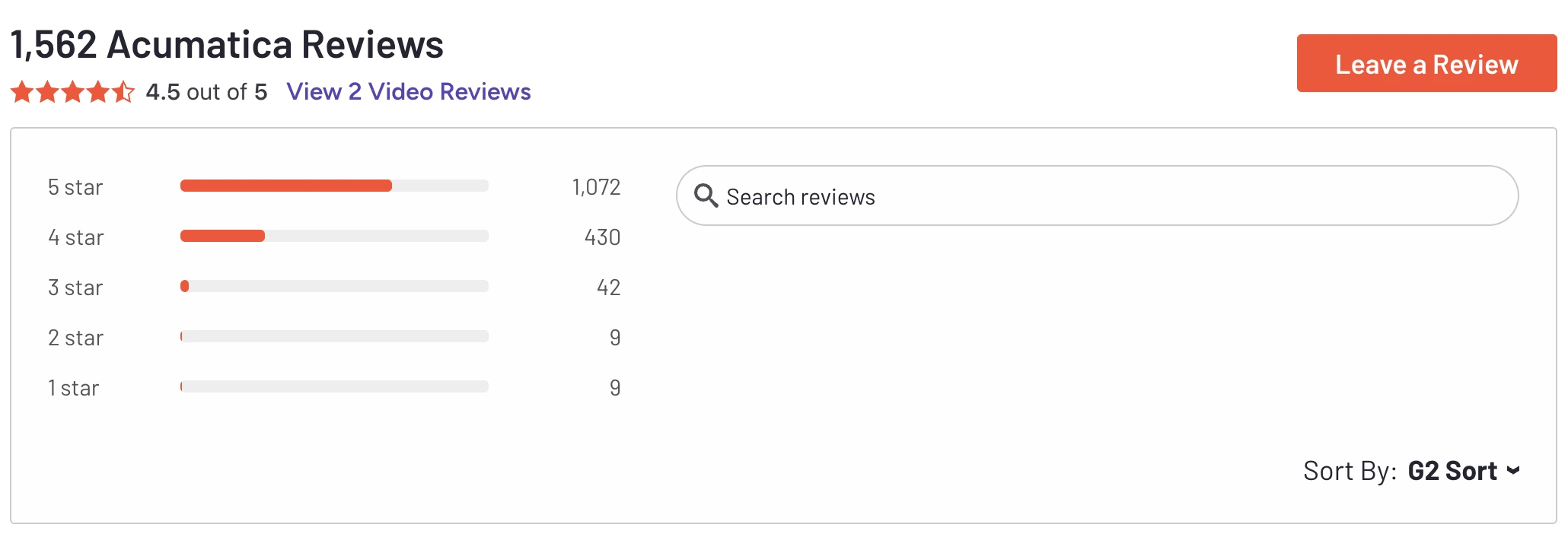Acumatica vs NetSuite: ERP Features and Cost Comparison
Sep 01, 2025

Choosing the right ERP (Enterprise Resource Planning) system is one of the most critical decisions a business can make. The right ERP can streamline operations, improve financial visibility, and support long-term growth. On the other hand, the wrong choice can lead to high costs, complex implementations, and limited scalability.
Two of the most popular cloud-based ERP systems in the market today are NetSuite and Acumatica. Both target growing and mid-market businesses but differ significantly in features, deployment models, pricing, and scalability.
This blog provides a detailed, side-by-side comparison of NetSuite vs Acumatica so decision makers, CEOs, CFOs, and operations leaders can make an informed choice based on their company’s unique requirements.
NetSuite, owned by Oracle, is one of the first and most widely adopted cloud ERP solutions in the world. It serves more than 37,000 organizations across 200+ countries and is known for its scalability and global business management capabilities.
In short, NetSuite is designed for businesses that want a unified, highly scalable ERP with global capabilities.
Acumatica is a younger but fast-growing ERP provider founded in 2008. Unlike NetSuite, Acumatica is not owned by a large corporation but has positioned itself as a flexible and cost-effective alternative for small to mid-market businesses.
Acumatica appeals to mid-sized businesses that want ERP flexibility, modern functionality, and lower upfront cost compared to larger players like NetSuite.
Below is a focused, easy-to-scan features comparison designed for business owners and decision makers.
First you’ll see a one-page overview table to orient the team, then a clear, plain-English deep dive for each feature area with a short decision signal and a real-world example where helpful.
NetSuite
NetSuite provides an enterprise-grade General Ledger, fully integrated with Accounts Payable, Accounts Receivable, Fixed Assets, and Cash Management. It supports multi-subsidiary and multi-currency operations with automated intercompany eliminations. Advanced reporting and dashboards allow CFOs and finance teams to consolidate global financials quickly. The system also supports multi-GAAP and IFRS reporting and includes pre-configured compliance packs for audit trails and regulatory requirements.
Acumatica
Acumatica offers a flexible General Ledger with multiple charts of accounts and project/job-level accounting. Its AP/AR modules are tightly integrated with project costing and allocations. Fixed asset management is included, and accounting processes are easier to configure for mid-market or project-focused companies. Consolidation for multi-entity setups is supported but often requires partner assistance for complex international operations.
| Feature | NetSuite | Acumatica |
|---|---|---|
| General Ledger | Enterprise-grade, multi-GAAP/IFRS, automated intercompany | Flexible, multi-chart, project/job-level accounting |
| Accounts Payable / Receivable | Automated, multi-currency, intercompany AP/AR | Integrated with project/job accounting |
| Fixed Assets | Automated depreciation, revaluation, multi-currency support | Depreciation and asset tracking, manual setup |
| Consolidation | Automatic intercompany eliminations, multi-subsidiary | Supported, may require partner setup |
| Compliance & Audit | Pre-configured packs, audit trails | Available, depends on hosting and setup |
NetSuite
NetSuite OneWorld allows multi-subsidiary, multi-currency, and multi-tax configurations. It automates intercompany transactions and offers country-specific tax localizations and reports. This makes it ideal for global enterprises managing complex tax and legal entity requirements.
Acumatica
Acumatica supports multiple companies and intercompany transactions. Tax handling is flexible but often relies on partner modules or custom configurations for local tax compliance. Deployment flexibility allows integration with regional tax engines if needed.
| Feature | NetSuite | Acumatica |
|---|---|---|
| Multi-company support | Unlimited subsidiaries, intercompany automation | Multiple companies, may require partner assistance |
| Tax handling | Country-specific tax packs, automated calculations | Flexible, often requires partner setup |
| Currency management | Multi-currency with automatic conversion | Multi-currency supported |
| Intercompany transactions | Fully automated | Supported, may need setup |
NetSuite
NetSuite’s Advanced Revenue Management (ARM) module handles complex revenue recognition and subscription billing. It automates ASC 606 compliance, multi-element arrangements, deferred revenue, and multi-currency billing. The system integrates tightly with order-to-cash, CRM, and finance modules, providing real-time visibility into recurring revenue streams and financial impact.
Acumatica
Acumatica supports recurring billing and subscription management, including progress billing and contract-based invoicing. Revenue recognition can be configured, but advanced multi-element or automated ASC 606 compliance usually requires partner solutions or custom configuration. Integration with project accounting allows alignment of billing with project costs.
| Feature | NetSuite | Acumatica |
|---|---|---|
| Revenue recognition | Automated, ASC 606 compliant, multi-element support | Configurable, may need partner/customization |
| Subscription billing | Supports multiple billing schedules, automated invoicing | Recurring billing, progress invoicing |
| Multi-currency billing | Fully supported | Supported |
| Integration with finance & CRM | Fully integrated | Integrated with project accounting; CRM via connectors |
NetSuite
NetSuite offers advanced inventory management and warehouse capabilities. It supports multi-location inventory, lot and serial tracking, bin management, cycle counts, and automated reorder points. NetSuite’s WMS integrates with eCommerce and 3PL systems, enabling real-time inventory visibility across channels.
Acumatica
Acumatica provides inventory management for mid-market businesses, including multi-location support, lot and serial tracking, and basic warehouse processes. It integrates with external eCommerce and logistics solutions. Advanced WMS features are available through add-ons or partner solutions.
| Feature | NetSuite | Acumatica |
|---|---|---|
| Multi-location inventory | Yes, fully integrated | Yes |
| WMS functionality | Advanced, native, cycle counts, automated workflows | Mid-market WMS, basic workflows |
| Lot/serial tracking | Supported | Supported |
| eCommerce & 3PL integration | Native integration | Via connectors/add-ons |
NetSuite
NetSuite offers robust manufacturing capabilities, including MRP, demand planning, production scheduling, BOM and routing management, and capacity planning. It supports multi-site production and integrates with inventory, supply chain, and finance modules.
Acumatica
Acumatica provides manufacturing functionality tailored for job-shop and make-to-order environments. It includes BOM, routing, work orders, scheduling, and shop-floor tracking. The platform is well-suited for mid-market manufacturers seeking operational flexibility.
| Feature | NetSuite | Acumatica |
|---|---|---|
| Production planning | Advanced MRP, multi-site | Job-shop & make-to-order focus |
| BOM & routing | Supported | Supported |
| Shop-floor tracking | Supported | Strong mobile/field tracking |
| Demand planning | Advanced forecasting | Basic planning |
NetSuite
NetSuite provides strong project accounting capabilities suitable for professional services organizations. Features include time and expense tracking, project budgeting, resource allocation, billing and invoicing, and revenue recognition. The system allows integration with finance, CRM, and billing modules to provide real-time project profitability insights.
Acumatica
Acumatica excels in construction and project-driven industries. Its job-costing and project accounting modules include progress billing, commitment tracking, change orders, and mobile field entry for time and expense. The system allows tight integration between project costs and revenue, providing operational control over each job.
| Feature | NetSuite | Acumatica |
|---|---|---|
| Time & expense tracking | Supported | Supported, mobile field entry |
| Project budgeting | Advanced, integrated | Supported, flexible |
| Billing & invoicing | Integrated with finance & CRM | Progress billing & contract invoicing |
| Revenue recognition | Supported, automated | Configurable, may need customization |
| Job costing | Integrated with accounting | Strong job-costing features |
NetSuite
NetSuite provides native CRM integrated with the ERP. Features include lead management, opportunity tracking, sales forecasting, customer support, and marketing automation. SuiteCommerce provides a fully integrated eCommerce solution for B2B and B2C businesses, reducing the need for separate systems or connectors.
Acumatica
Acumatica includes a CRM module with lead, opportunity, and customer management. Ecommerce is typically implemented via connectors to platforms like Shopify or BigCommerce. Sales and customer data can integrate with the ERP, but it may require additional configuration for unified workflows.
| Feature | NetSuite | Acumatica |
|---|---|---|
| CRM functionality | Native, fully integrated | Native, integrated with ERP |
| Sales order management | Fully integrated | Supported, may require configuration |
| eCommerce | Native SuiteCommerce | Via connectors |
| Marketing automation | Integrated | Limited, may require add-ons |
NetSuite
NetSuite offers SuiteAnalytics for real-time dashboards, saved searches, and workbook analytics. Advanced users can leverage SuiteAnalytics Warehouse for data warehousing and BI integration, allowing enterprise-wide reporting and advanced visualization across multiple subsidiaries and data sources.
Acumatica
Acumatica provides robust operational dashboards and reporting tools. Data can be accessed via OData or REST endpoints, making it easy to integrate with Power BI or Excel for advanced analytics. Reports are highly customizable and allow real-time visibility into operational KPIs.
| Feature | NetSuite | Acumatica |
|---|---|---|
| Dashboards | Real-time, role-based | Real-time, customizable |
| Ad-hoc reporting | SuiteAnalytics saved searches/workbooks | Custom reports via OData/Excel/Power BI |
| BI & data warehousing | SuiteAnalytics Warehouse | External BI via connectors |
| KPI monitoring | Built-in | Built-in |
NetSuite
NetSuite provides a comprehensive customization framework via SuiteCloud, which includes SuiteScript (JavaScript), SuiteFlow (workflow automation), and SuiteTalk (SOAP/REST APIs). Businesses can create custom fields, forms, workflows, and scripts, and leverage a large SuiteApp marketplace for pre-built integrations. This makes NetSuite highly extensible for complex enterprise needs.
Acumatica
Acumatica is built on the xRP platform with .NET technology. It provides REST and SOAP APIs, OData endpoints, and configurable screens, dashboards, and workflows. Its open architecture allows developers to customize forms, modules, and integrations efficiently, especially for organizations with .NET development teams.
| Feature | NetSuite | Acumatica |
|---|---|---|
| Platform | SuiteCloud (JavaScript, workflows, SuiteApps) | xRP (.NET) |
| APIs | SuiteTalk (SOAP/REST), SuiteScript | REST/SOAP APIs, OData |
| Workflows | SuiteFlow | Configurable workflows |
| Marketplace / pre-built integrations | Large SuiteApp ecosystem | Growing partner/connector network |
NetSuite
NetSuite is a 100% cloud-native SaaS platform. Upgrades are managed by Oracle, typically twice per year. Security is handled centrally with enterprise-grade controls, including SOC and ISO certifications, encryption, and multi-factor authentication. Data residency and compliance are standardized through the vendor’s infrastructure.
Acumatica
Acumatica offers cloud-based deployment, private cloud, and hybrid options. Upgrades can be managed by the customer or partner depending on deployment choice. Security depends on hosting: SaaS inherits cloud provider certifications, while private deployments require customer-managed compliance. It provides encryption, role-based access, and audit trails.
| Feature | NetSuite | Acumatica |
|---|---|---|
| Deployment options | SaaS only | SaaS, private cloud, hybrid |
| Upgrade management | Vendor-managed, twice yearly | Customer/partner managed |
| Security | Enterprise-grade, SOC/ISO certified | Cloud provider or customer managed |
| Data residency | Standardized | Flexible depending on hosting |
NetSuite
NetSuite has a large global partner ecosystem and extensive ISV marketplace. Certified consultants and developers are widely available, enabling faster implementation, industry-specific configurations, and support. Its SuiteApp ecosystem covers CRM, commerce, industry modules, and integrations.
Acumatica
Acumatica has a growing partner network, strong in North America and regional markets. It supports industry-specific editions and provides integrations via partners. While smaller than NetSuite’s global ecosystem, it offers focused expertise for mid-market businesses and niche industries.
| Feature | NetSuite | Acumatica |
|---|---|---|
| Partner network | Large, global | Growing, regional |
| ISV marketplace | Extensive SuiteApps | Limited, partner-driven |
| Industry support | Wide, enterprise-grade | Strong mid-market editions |
| Talent availability | Large pool of consultants/developers | Smaller pool, focused |
NetSuite
Users on G2 appreciate NetSuite’s robust features for revenue management and financial reporting. One reviewer highlighted its seamless flow from sales orders to invoicing, praising the system’s user-friendliness and customizable reports.

Acumatica
Acumatica is lauded for its intuitive interface and comprehensive functionality on. A reviewer on G2 with 20 years in accounting noted discovering new modules even after four years of daily use, emphasizing its user-friendly design and extensive capabilities.

Both NetSuite and Acumatica are strong ERP platforms, but they serve different business needs. NetSuite excels for large, complex, global operations that require advanced automation and scalability. Acumatica is ideal for mid-market companies seeking flexibility, lower total cost of ownership, and strong project or job accounting capabilities.